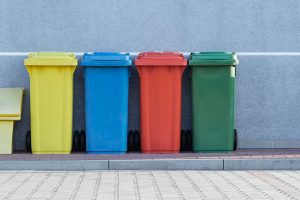
Buying a trash compactor for your business is an important investment. Most companies will research compactors for sale before they sign on the dotted line.
Realizing an acceptable return on your investment (ROI) depends on selecting the best trash compactor for your facility’s specific needs. With the right compactor for the job, your company can see an ROI in one to two years.
There are two primary factors that affect trash compactor cost savings. They include:
- The process of collecting compacted waste and placing it into the compactor.
- The cost associated with hauling waste to landfill, waste-to-energy (WtE), or recycling locations.
Which Is The Right Compactor To Invest In?
Two common types of trash compactors are RAM-style industrial units and rotary-style trash compactors:
- RAM-style compactors can usually compact a variety of waste material at a ratio of two to three times.
- A rotary arm compactor such as the RotoPac, a KenBay compactor, can compact waste material at a ratio of six to eight times plus remove the air, which will decrease your hauling costs considerably.
How Does A Trash Compactor Enable Savings?
The best trash compactors help your business save on labor and hauling costs. Labor savings can grow when the compactor is located as close to the waste sources as possible. Once the waste is compacted, the cost of transporting it is generally reduced by the ratio of compaction.
 The ideal in labor savings is to eliminate as much physical labor as possible by continuously conveying the waste from its source to the compactor. Belt conveyors can be used effectively for various sources of waste. Conveying can be done pneumatically for numerous applications, especially ones like label-making trim. Cost savings are more easily realized with a compactor like the RotoPac that uses high torque rotation and a sweeping drum to not only compact waste but also to remove the maximum amount of air from the waste continuously.
The ideal in labor savings is to eliminate as much physical labor as possible by continuously conveying the waste from its source to the compactor. Belt conveyors can be used effectively for various sources of waste. Conveying can be done pneumatically for numerous applications, especially ones like label-making trim. Cost savings are more easily realized with a compactor like the RotoPac that uses high torque rotation and a sweeping drum to not only compact waste but also to remove the maximum amount of air from the waste continuously.
Other trash compactor cost savings include:
- Reduction in the cost of transporting compacted waste.
- Reduction in miles traversed getting the waste to its final destination.
- Reduction in forklift usage and operator time, which also increases safety.
- Reduction in facility floor space usage by eliminating staging areas for uncompacted waste and having to keep it clean, as well as not requiring a shipping bay for removing trash from the warehouse.
Your company can also realize cost savings by:
- Planning effectively for a trash compactor installation.
- Managing the waste removal process by reviewing hauling costs as changes occur and considering competitive sourcing of different technologies.
- Reviewing negotiated contracts with landfill, WtE, or recycling locations.
- Staying informed on the market price for the material being recycled.
What Are The Monetary Benefits of a Rotary Arm Compactor?
Purchasing a rotary arm compactor such as the RotoPac™ Industrial Waste Compactor provides for a safe alternative to the larger RAM compactors available because the KenBay compactor needs no skilled operator or designated supervision to operate. It has features that improve safety even further, such as:
- An isolator switch for complete shut-down
- A conveniently located emergency stop switch
- A motor overload protector with automatic shut-down to prevent machine burnout
- A slab-sided design that prevents climbing
- A safer machine means less injuries, which means less worker downtime.
How Long Can I Expect Cost Savings From My Compactor?
With US-made components and a high-end fabricating process designed to sit either inside or outside, a well-built industrial compactor like the KenBay RotoPac compactor will provide 16 years of quality use on average.
When you factor this into ROI calculations, you’ll find that the answer to your waste removal needs may be a rotary arm compactor. It can even improve your facility’s carbon footprint by providing fewer collections that need less land space.


